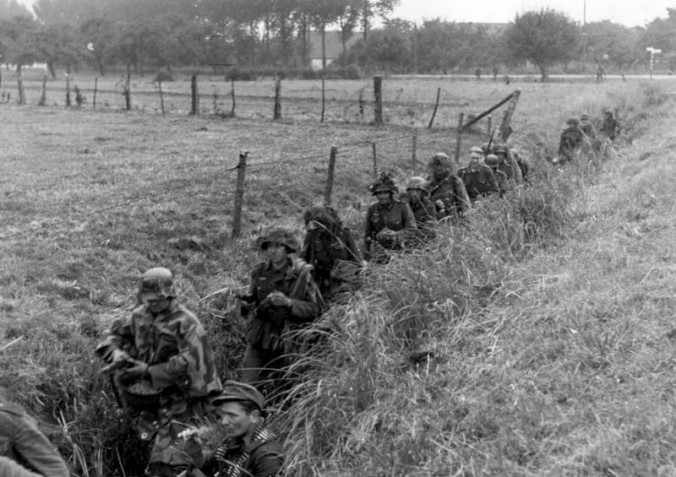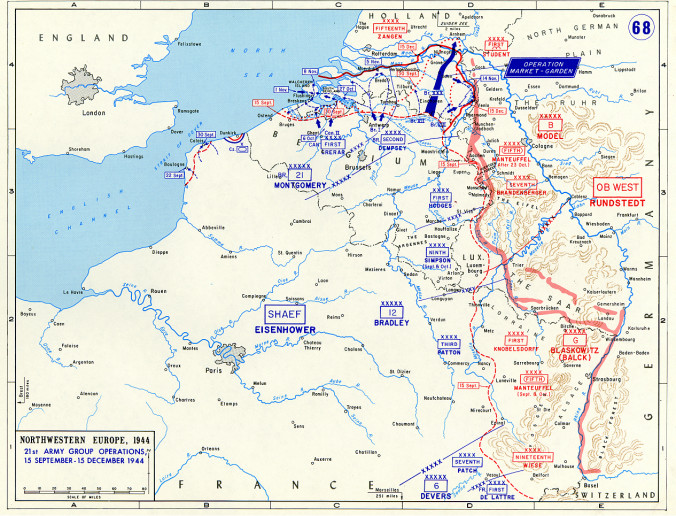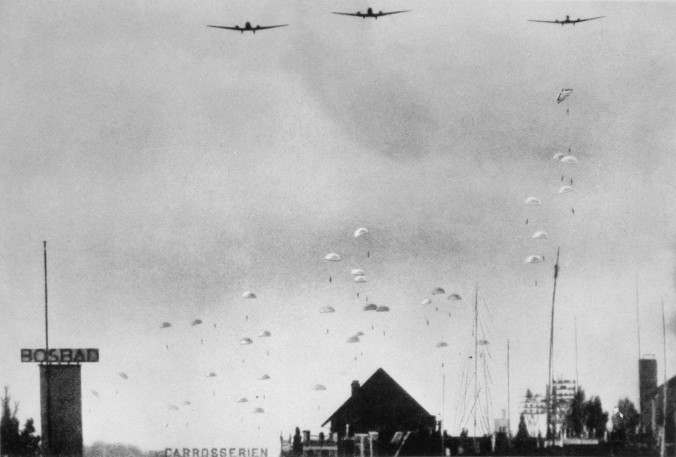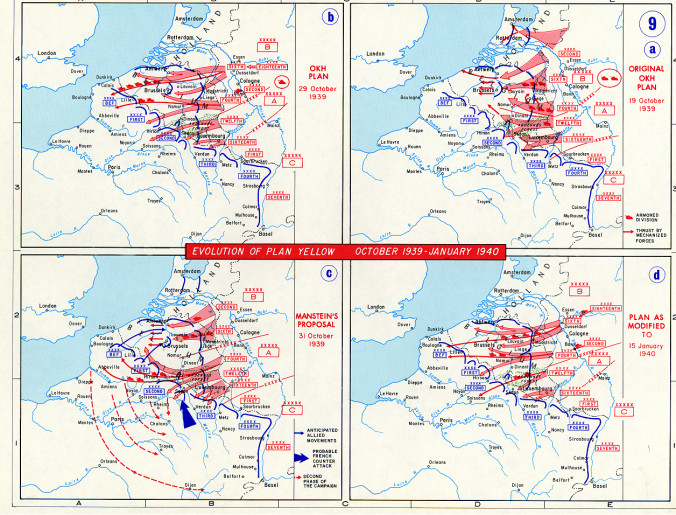German commandos moved into Holland as early as midnight and the first reports of Germans crossing the frontier reached Dutch supreme headquarters at 0300 on May 10. Germany began the main attack at 0355, when bombers struck at The Hague, airfields, barracks, and bridge garrisons in and south of Rotterdam. Dutch supreme headquarters issued a general alarm at 0415, too late to alert defenders at many key points.[16] The fact that the Dutch and Belgians had already endured eight months of Sitzkrieg, punctuated by numerous false alarms, greatly enhanced the chance of surprise.
At about 0400 475 Ju-52 transport aircraft arrived over their targets, covered by fighters which strafed drop zones, landing areas, and nearby towns. Although Germany employed two divisions in the air assault, only 4,500 of the 16,500 men were trained parachutists (Fallschirmjaeger). The bulk of the force landed by transport aircraft. As part of the bid to decapitate the Dutch government, six companies of Fallschirmjaeger from Lt. Gen. Students Fliegerdivision 7 attempted to capture three airfields near The Hague. Paratroopers got scattered at two of the airfields, due to inaccurate drops. Construction had not been completed at the third air base, where transports attempted to land anyway. Many of the Ju-52s sank into the soft soil. Unable to take off, a large number were soon destroyed. These mishaps caused the operation to capture the Dutch government to fall apart. Airdrops near the bridges at Rotterdam, Moerdijk and Dordrecht proved more successful. In a different style of air assault, seaplanes landed near some of the bridges and disgorged assault troops. A few companies of Germans surprised and defeated two regiments of Dutch infantry, capturing the bridges intact.[17]
A combined parachute and glider assault captured the Waalhaven airfield south of Rotterdam, and it was here that most of the transports carrying the 22d LuftlandeDivision landed. General Students vertical assault achieved its most important objective; the bridges into Fortress Holland were taken. Although landings near The Hague did not go as planned, those troops took up defensive positions and tied down a large part of the Dutch First Corps, the main reserve of the Dutch Army.[18]
Commando-style attacks along the frontier met with few successes. Alerted the night before, Dutch frontier guards destroyed nearly all of the bridges. German commandos and Dutch Nazis did capture a railway bridge at Gennep by posing as Dutch soldiers. North of the Waal, bridges along the Ijssel river were destroyed. This did not significantly delay German forces, which arrived at the Grebbe Line as early as the afternoon of the tenth. In the far north the German 1st Cavalry Division met little resistance, nearly reaching the shore of the Ijsselmeer (Zuider Zee) by the end of the first day.
At about 0700 General Maurice Gamelin, the French Army Commander in Chief, ordered the initiation of the Allied defense plan. Leading elements of the French 25th Motorized Division crossed the Belgian border at about noon on May 10, and made the 150 kilometers to Antwerp by midnight. Other units from French Seventh Army advanced to the Dutch port of Breskens and crossed the Schelde estuary to Walcheren Island.[19]
At the end of the first day Dutch fortunes looked reasonable good. Although German airborne operations met with some success, Dutch forces fell back on their prepared defenses in good order. The Dutch First Corps had gained the upper hand in fighting around the capital, the French Army was on its way, and counterattacks were planned against Students positions at Waalhaven and the bridges leading into Fortress Holland.
That night German infantry forced the Dutch to withdraw from the Peel Line, and Colonel Schmidt, commander of the Dutch Peel Division started to lose contact with his subordinate units.[20] General Student sent his last available battalion at Waalhaven to reinforce the tenuous position in Dordrecht. This left the airfield temporarily undefended, but no Dutch attack materialized that night. The next morning more German troops were airlifted in, and by dark on the eleventh, Student had 4,500 troops and several light artillery batteries in his airhead south of Rotterdam.[21]
Major General Dr. Ritter von Hubickis 9th Panzer Division crossed the railway bridge at Gennep on the morning of May 11, followed by the motorized SS Verfuegungsdivision. Although most of the 9th Panzers 229 tanks were older vehicles, armed with machineguns instead of cannons, the Dutch could do little to stop them.[22] After crossing the Peel Line, General Hubicki divided his force. The SS division and one armored group turned south toward Tilburg. A second armored group, and the newly arrived SS motorized regiment Leibstandarte Adolf Hitlercontinued westward toward the paratroopers in Moerdijk. German cavalry reached the eastern shore of the Ijseelmeer by the end of the day on the eleventh. The Germans however, made no progress against the four Dutch infantry divisions holding the Grebbe Line.
French motorized units reached Tilburg ahead of the Germans, but outnumbered in tanks, were forced to fall back on Breda under heavy air attack. Two battalions of the French 25th Motorized Infantry Division also moved to Breda, one suffering heavy casualties from air attack while on the road.
Although General Winkelman managed to reinforce Rotterdam with four battalions, all French and Dutch attempts to attack the German position in Moerdijk and Dordrecht failed. Dutch artillery (including guns from the destroyer van Galen) and British air raids forced the Germans to suspend air operations at Waalhaven.[23]The Germans quickly switched to alternate landing areas, and General Student continued to receive supplies and reinforcements. Within thirty-six hours of the opening of battle, Gamelins Breda Variant, upon which was wagered his irreplaceable mobile reserves, had already been rendered null and void.[24] This turn of events profoundly impacted both the battle in Holland, and the campaign as a whole. Allied leaders were just becoming aware of the German attack in the Ardennes, but had not yet realized the extent of the problem they faced. The Dutch Government, now beyond effective allied help, faced crumbling civilian and military morale.[25]
During May 12 the Dutch continued to hold in the center and north. Along the Grebbe Line German infantry made some headway, but not enough to force the Dutch out of their fortifications. At the northeastern end of the Afsluitdijk, Dutch soldiers fought a numerically superior opponent to a standstill, despite strong German air and artillery support.[26] The main German attack continued to unfold in the south of Holland, and it was here that the fate of the country rested.
Tanks of the 9thPanzer Division arrived in Moerdijk on the morning of May 12. After crossing the Maas estuary at Moerdijk, the column turned north, linking up with Students Fallschrimjaegerssouth of Rotterdam in the early afternoon. German infantry continued mopping-up operations behind the armored spearhead, but there was no coherent resistance by the Dutch south of the Maas.[27]
On May 13 the military situation continued to deteriorate. Queen Wilhelmina and the cabinet boarded destroyers and sailed for England. Before leaving the Cabinet turned over full military and civil authority in Holland to General Winkelman. A last-minute instruction, phoned from the quay, ordered him to continue the struggle to the utmost, but, significantly, with avoidance of unnecessary sacrifices.[28]
Along the Grebbe Line Dutch units had been under constant pressure, and some were running low on ammunition. Fresh German units attacked and broke through the line at Rhenen. With its reserves tied down around the capital, the Dutch Army could not mount a counterattack, and began preparations to fall back to the East Front defense line. Controlled flooding constituted a major part of this final defense line. Unseasonably low water levels in the rivers caused the inundation to be far less effective than planned.[29]
At Rotterdam Dutch forces sealed off the German bridgehead. With no room to deploy their tanks the Germans were temporarily stalemated. General Kuechler brought Lieutenant General Rudolf Schmidts 39thCorps headquarters out of reserve to command the attack on Rotterdam. Schmidt had an infantry division, part the 9th Panzer, the airborne troops and the SS Leibstandarte Regiment at his disposal. Elsewhere in the south, Germans expanded their narrow penetration. The Dutch still held part of Dordrecht, but with the assistance of a Dutch officer (Lieutenant Colonel Mussert, brother of the Dutch Nazi party leader), German tanks broke into the town center.[30]
French units were forced out of Breda on May 13. With Germans crossing the Meuse at Sedan that same day, the French Army could no longer afford to attempt a rescue. Dutch units withdrew from the Grebbe Line to Fortress Holland during the night of May 13-14, with German forces pursuing the next morning.[31] During this advance 207thInfantry Division entered the Dutch town of Doorn, where the ex-Kaiser resided. An honor guard was posted, and German soldiers saluted Wilhelm II for the first time since 1918. Hitler ordered the guard withdrawn and declared the town off-limits to German forces.[32]
In Rotterdam events were moving toward a conclusion. At 0800 on May 14 the Germans presented an ultimatum demanding the city surrender by 1230 that day, but the German note was refused over a technicality. Before the corrected note reached the Dutch commander about sixty German bombers arrived. German soldiers tried to warn off the planes, but only a few turned away. Bombs hit the center of the old city and an uncontrollable fire soon developed. [33]
At 1500 Colonel Scharoo, Commandant of the Rotterdam garrison, in the presence of Generals Schmidt and Student, signed a cease fire order. Winkelman accepted the German surrender terms at about 1800, and the formal surrender was signed in Rotterdam at 0820 on May 15, 1940.[34]
Dutch troops in Zeeland had been transferred to allied command prior to the surrender, and continued the struggle until May17. Ground, naval and air forces which escaped The Netherlands continued to serve the Queen, as did all the forces stationed in Dutch overseas possessions. About 2,500 members of the Dutch military died in the five-day war, along with a similar number of civilians. Dutch prisoners of war were soon released, but the country endured five years of increasingly restrictive occupation.
Although 22ndLuftlandesuffered heavily and landings near The Hague did not go as planned, those troops did tie down a large part of the Dutch First Corps, the main reserve of the Dutch Army.[35] The remaining forces under Student fought off successive Dutch counterattacks and held open an airborne carpet for five days, facilitating a rapid German advance over several water obstacles, and ensuring the collapse of Dutch resistance. 7thFliegerhad only 180 killed and wounded, with Student among the wounded.[36] It is believed that an SS sniper fired the bullet which penetrated Students skull, leaving him with permanent speech impairment.[37]
Hitler congratulated his victorious forces by saying: In five days you have attacked, broken the air defenses and in the end forced the surrender of a strong well prepared army defending itself bravely behind seemingly unbeatable obstacles….[38]
The Dutch Army prepared a set-piece defense, but Germany failed to provide the accompanying set-piece attack. A post-war Dutch inquiry commission concluded any really effective defense strategy would have required large-scale preparatory talks with the Belgians and French.[39]Under the prevailing circumstances, better Dutch decision making would have resulted in a slightly longer battle, and ultimately, in the same outcome to an unequal struggle.
Footnotes
[16] Ibid.,
565-6.
[17] Mason,
567.
[18] Farrar-Hockley,
Student, 69-73.
[19] Chapman,
95-6.
[20] Steenbeek, 74.
[21] Farrar-Hockley, Student, 73-74.
[22] Bryan
Perrett, Knights of the Black Cross:
Hitlers Panzerwaffe and Its Leaders(New York: St. Martins Press, 1986),
43-4.
[23] Eelco
Nicholaas van Kleffens, Juggernaut Over
Holland; The Dutch Foreign Ministers Personal Story of the Invasion of The
Netherlands (New York: Columbia University Press, 1941),130.
[24] Alistair
Horne, To Lose a Battle: France 1940,
(Boston: Little, Brown and Company, 1969), 242.
[25] Steenbeek,
73; van Kleffens, 125-6.
[26] Mason,
570.
[27] Taylor,
198.
[28] Mason,
575.
[29] Steenbeek,
115-6
[30] Ibid.,
100.
[31] Taylor,
196, 198-9.
[32] Ibid.,
196.
[33] Steenbeek, 123-9.
[34] Mason,
576-7; Taylor, 200-2.
[35] Farrar-Hockley, Student,
69-74.
[36] Ibid., 75; B. H. Liddell-Hart,
The German Generals Talk(New York:
William Morrow and Company, 1948), 118.
[37] Lucas, 181; Charles Whitting, Hunters from the Sky: The German Parachute
Corps 1940-1945 (New York: Stein
and Day, 1974),54; Steenbeek 137.
[38] Steenbeek,
143.
[39] Mason, 559.



